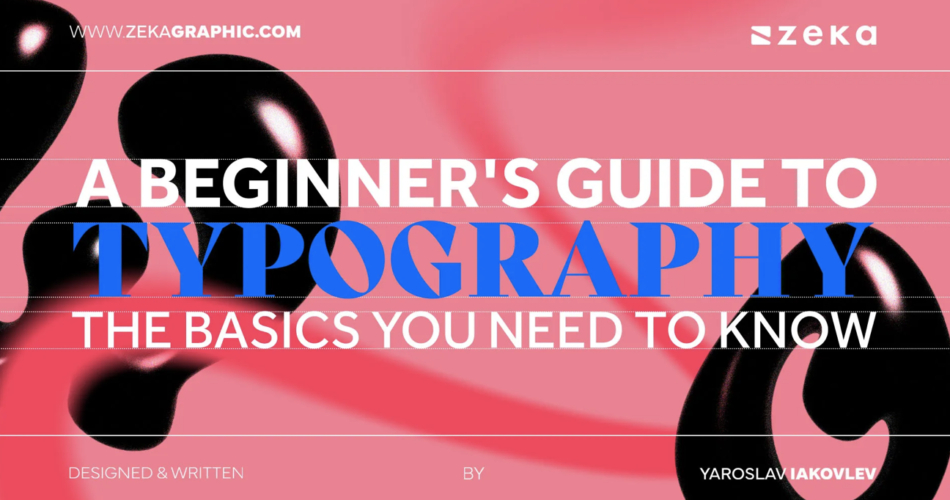Typography is an art form that surrounds us every day, from the books we read to the websites we visit and the signs we encounter. It’s the art and technique of arranging type to make written language legible, readable, and visually appealing. Whether you’re a graphic designer, a writer, a student, or just someone interested in the world of design, understanding the basics of typography is essential. In this beginner’s guide, we’ll explore fonts, typefaces, and the principles that govern their usage.
Contents
Understanding the Difference: Fonts vs. Typefaces
Before we delve into the nuances of typography, it’s crucial to understand the distinction between fonts and typefaces, as these terms are often used interchangeably but refer to different things.
Typeface: A typeface, also known as a font family, is a collection of characters that share a consistent design. For example, Times New Roman, Helvetica, and Arial are all typefaces. Each typeface consists of various styles, such as regular, bold, italic, and more.
Font: A font, on the other hand, is a specific style and size within a typeface. For instance, Times New Roman 12pt, Times New Roman 14pt, and Times New Roman 16pt are all fonts within the Times New Roman typeface.
In summary, a typeface is like a family, and fonts are the individual members of that family with varying attributes.
Anatomy of Typography
Typography has its own unique terminology that helps describe the anatomy of letterforms. Understanding these terms is essential for discussing and working with typography effectively:
- Baseline: The imaginary line upon which the letters in a typeface sit.
- X-Height: The height of lowercase letters, typically measured from the baseline to the top of letters like “x” and “a.” It’s an important factor in determining a typeface’s legibility.
- Cap Height: The height from the baseline to the top of uppercase letters. It helps maintain uniformity in a typeface.
- Ascenders: The parts of lowercase letters that extend above the x-height, such as the upper portions of “b,” “d,” and “h.”
- Descenders: The parts of lowercase letters that extend below the baseline, such as the tails on “g,” “p,” and “q.”
- Kerning: The process of adjusting the space between individual characters to improve the overall visual balance of a text.
- Leading: The vertical space between lines of text, measured from baseline to baseline. Appropriate leading ensures readability and aesthetics.
- Tracking: The uniform spacing between characters in a block of text. Adjusting tracking can affect readability and visual impact.
Choosing the Right Typeface
Selecting an appropriate typeface is a critical decision in any design project. Here are some considerations to keep in mind when choosing a typeface:
- Purpose: Consider the context and purpose of your text. Is it for a formal document, a playful advertisement, or an informative website? The typeface should align with the message and tone.
- Legibility: Ensure that the typeface is easy to read. Avoid overly decorative or script fonts for body text, as they can hinder legibility.
- Hierarchy: Use different typefaces and font styles (bold, italic, etc.) to create a visual hierarchy in your design. Headers should stand out from body text.
- Consistency: Stick to a limited number of typefaces within a project to maintain visual cohesion. A combination of a serif and a sans-serif typeface often works well.
- Accessibility: Pay attention to accessibility guidelines, such as ensuring sufficient contrast between text and background colors, to make your content inclusive to all readers.
Typography in Practice
Now that you have a basic understanding of typography, let’s explore how it’s used in various mediums:
- Print Design: Typography plays a pivotal role in everything from books and magazines to brochures and posters. It helps convey the message and creates a visual identity for the publication.
- Web Design: Effective web typography considers screen resolutions, responsiveness, and readability. Web designers choose web-safe fonts or use web font services to ensure consistent rendering across devices.
- Branding: Typography is a crucial aspect of brand identity. Brands like Coca-Cola and Disney are instantly recognizable by their custom typefaces.
- Advertising: In advertising, typography can be used creatively to grab attention and communicate the brand’s message. Playful fonts may be used for a children’s toy ad, while elegant, serif fonts may suit a luxury product.
- User Interfaces (UI): UI designers rely on typography to provide clear instructions and enhance the user experience. Clear and readable fonts are a must for intuitive interfaces.
The Power of Typography
Typography is more than just choosing pretty fonts; it’s about effective communication and visual storytelling. The right typography can evoke emotions, convey information, and leave a lasting impression. As you explore the world of typography, remember that practice and experimentation are key to mastering this art form. Start by studying different typefaces, understanding their characteristics, and experimenting with them in your own design projects. With time and dedication, you’ll develop a keen eye for typography and its impact on visual communication.
